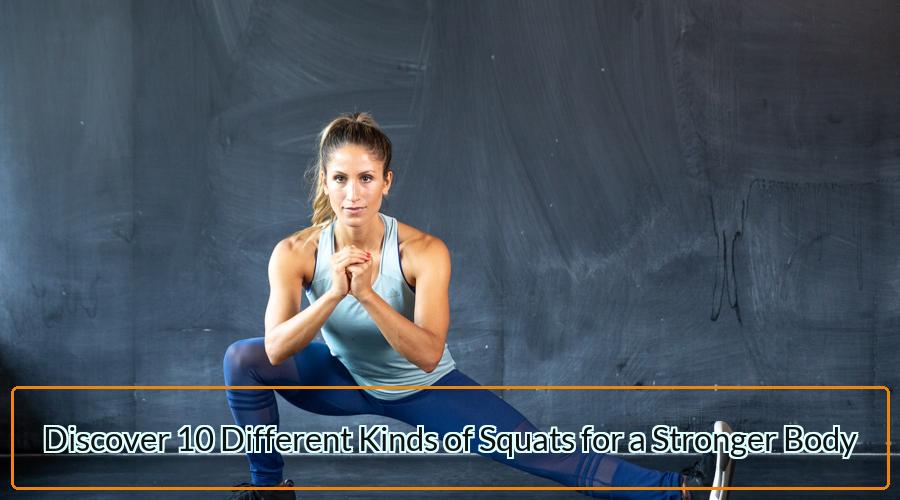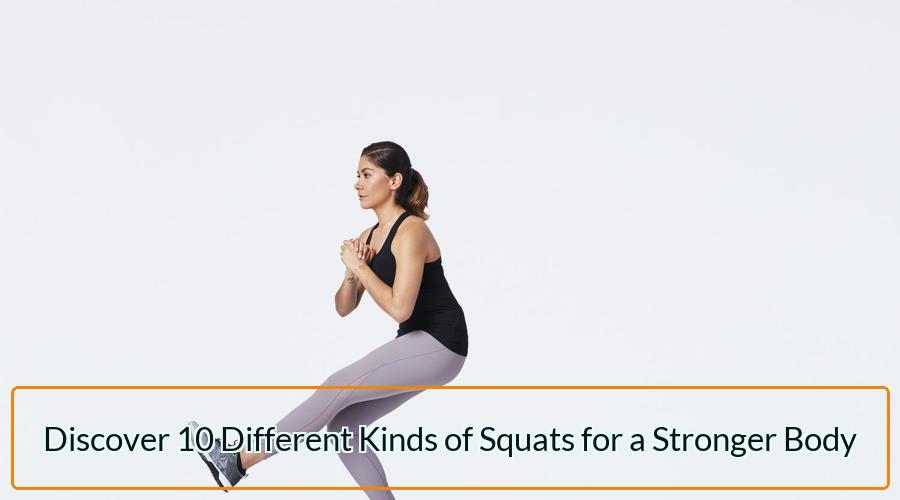
Are you looking to take your fitness routine to the next level? Look no further than the humble squat! Squats are one of the most effective exercises you can do to strengthen your lower body, including your legs, glutes, and core. Not only that, but they can also improve your balance, flexibility, and overall athleticism.
But with so many different kinds of squats out there, it can be tough to know where to start. That’s why we’ve put together this guide to 10 different kinds of squats that will help you boost your fitness routine. Whether you’re a beginner or a pro, there’s a squat variation here for you. From classic squats to jump squats, front squats to goblet squats, we’ll cover the benefits of each exercise, how to perform them properly, and how to incorporate them into your workout routine. So get ready to squat your way to a stronger, fitter you!
Importance of Squats For Overall Fitness
Squats are one of the most effective exercises you can do to improve your overall fitness. They primarily target your lower body muscles, including your quads, hamstrings, glutes, and calves, but they also engage your core and lower back muscles for stability and balance. This makes squats a compound exercise that works multiple muscle groups at once, making them a time-efficient way to get a full-body workout.
In addition to building muscle, squats can also improve your cardiovascular health by increasing your heart rate and oxygen consumption. This can lead to improved endurance and stamina, which can be especially beneficial for athletes or those who enjoy high-intensity activities.
Squats also have functional benefits that can improve your daily life, such as improving your ability to lift heavy objects, climb stairs, and perform other activities that require lower body strength and stability.
Furthermore, squats can help improve your posture and reduce your risk of injury by strengthening the muscles that support your spine and pelvis. This can also improve your balance and coordination, making you less prone to falls and other accidents.
Overall, incorporating squats into your fitness routine can have numerous benefits for your health and well-being. With so many different kinds of squats to choose from, you can easily customize your workout to suit your fitness level and goals.
Read more about Turinabol vs Dianabol
10 Different Kinds of Squats
Basic Squats
The basic squat, also known as the bodyweight squat, is a foundational squat exercise that targets the lower body muscles.
Step-by-step guide:
- Stand with your feet shoulder-width apart, toes pointing forward or slightly outward.
- Engage your core muscles and maintain a neutral spine throughout the movement.
- Bend your knees and lower your hips back and down, as if you are sitting in a chair.
- Keep your weight in your heels and your knees tracking over your toes.
- Lower until your thighs are parallel to the ground or slightly below.
- Pause briefly, then push through your heels to return to the starting position.
- Repeat for the desired number of repetitions.
Sumo Squats
The sumo squat is a variation of the squat where the feet are wider apart and the toes point outward, emphasizing the inner thigh muscles.
Step-by-step guide:
- Stand with your feet wider than shoulder-width apart, toes pointing out at a 45-degree angle.
- Engage your core muscles and maintain a neutral spine throughout the movement.
- Bend your knees and lower your hips back and down, as if you are sitting in a sumo wrestler stance.
- Keep your weight in your heels and your knees tracking over your toes.
- Lower until your thighs are parallel to the ground or slightly below.
- Pause briefly, then push through your heels to return to the starting position.
- Repeat for the desired number of repetitions.
Jump Squats
The jump squat is a plyometric squat exercise that involves explosive power and strengthens the leg muscles.
Step-by-step guide:
- Start with a basic squat, but as you come up, jump off the ground explosively.
- Land softly and lower yourself back down into the squat position.
- Repeat for the desired number of repetitions. Note: This exercise is high-impact and may not be suitable for individuals with joint or mobility issues.
Goblet Squats
The goblet squat is a squat variation that uses a weight held in front of the chest to increase resistance and target the legs, core, and upper body muscles.
Step-by-step guide:
- Hold a dumbbell or kettlebell with both hands at chest level.
- Stand with your feet shoulder-width apart, toes pointing forward or slightly outward.
- Engage your core muscles and maintain a neutral spine throughout the movement.
- Bend your knees and lower your hips back and down, as if you are sitting in a chair.
- Keep your weight in your heels and your knees tracking over your toes.
- Lower until your thighs are parallel to the ground or slightly below.
- Pause briefly, then push through your heels to return to the starting position.
- Repeat for the desired number of repetitions.

Pistol Squats
Pistol Squats Definition: The pistol squat, also known as the one-legged squat, is a challenging squat exercise that targets one leg at a time, building strength and balance.
Step-by-step guide:
- Stand on one leg with your other leg extended in front of you.
- Engage your core muscles and maintain a neutral spine throughout the movement.
- Bend your standing leg and lower your hips back and down, as if you are sitting in a chair.
- Keep your weight on your heel and your knee tracking over your toes.
- Lower until your thigh is parallel to the ground or slightly below.
- Pause briefly, then push through your heel to return to the starting position.
- Repeat for the desired number of repetitions on one leg before switching to the other leg.
Front Squats
The front squat is a squat variation that involves holding a barbell in front of the body, targeting the legs, core, and upper body muscles.
Step-by-step guide:
- Stand with your feet shoulder-width apart and hold the barbell with an overhand grip, elbows pointing forward and up.
- Engage your core muscles and maintain a neutral spine throughout the movement.
- Bend your knees and lower your hips back and down, as if you are sitting in a chair.
- Keep your weight in your heels and your elbows pointing up.
- Lower until your thighs are parallel to the ground or slightly below.
- Pause briefly, then push through your heels to return to the starting position.
- Repeat for the desired number of repetitions.
Read more about Dumbbell Narrow Squats
Bulgarian Split Squats
The Bulgarian split squat is a lunge-like squat exercise that targets one leg at a time, building strength and balance.
Step-by-step guide:
- Stand with one foot forward and the other foot behind you, resting on a bench or elevated surface.
- Engage your core muscles and maintain a neutral spine throughout the movement.
- Bend your front knee and lower your hips down, keeping your weight in your heel.
- Lower until your thigh is parallel to the ground or slightly below.
- Pause briefly, then push through your heel to return to the starting position.
- Repeat for the desired number of repetitions on one leg before switching to the other leg.
Box Squats
The box squat is a squat variation that involves sitting on a box or bench before standing back up, building strength and power.
Step-by-step guide:
- Stand with your feet shoulder-width apart, toes pointing forward or slightly outward.
- Place a box or bench behind you at the appropriate height.
- Engage your core muscles and maintain a neutral spine throughout the movement.
- Bend your knees and lower your hips back and down, sitting on the box or bench.
- Pause briefly, then push through your heels to stand back up to the starting position.
- Repeat for the desired number of repetitions.
Overhead Squats
The overhead squat is a squat variation that involves holding a weight overhead, building strength and stability in the upper body.
Step-by-step guide:
- Hold a barbell or weight plate overhead with both hands and arms fully extended.
- Stand with your feet shoulder-width apart, toes pointing forward or slightly outward.
- Engage your core muscles and maintain a neutral spine throughout the movement.
- Bend your knees and lower your hips back and down, as if you are sitting in a chair.
- Keep your weight in your heels and your arms extended overhead.
- Lower until your thighs are parallel to the ground or slightly below.
- Pause briefly, then push through your heels to return to the starting position.
- Repeat for the desired number of repetitions.

Landmine Squats
The landmine squat is a squat variation that involves holding one end of a barbell while the other end is anchored, building strength and stability in the upper body.
Step-by-step guide:
- Place one end of the barbell in a landmine anchor or a corner of a wall.
- Hold the other end of the barbell with both hands at chest level.
- Stand with your feet shoulder-width apart, toes pointing forward or slightly outward.
- Engage your core muscles and maintain a neutral spine throughout the movement.
- Bend your knees and lower your hips back and down, as if you are sitting in a chair.
- Keep your weight in your heels and your elbows close to your body.
- Lower until your thighs are parallel to the ground or slightly below.
- Pause briefly, then push through your heels to return to the starting position.
- Repeat for the desired number of repetitions.
These 10 different kinds of squats provide a variety of options to target different muscle groups and levels of fitness. By incorporating these exercises into your fitness routine, you can challenge yourself and improve your overall strength and endurance. However, it’s important to start with the basic squat and gradually progress to more challenging exercises to avoid injury and ensure proper form.
Conclusion
In conclusion, squats are an excellent exercise for improving overall fitness and can be adapted to suit different fitness levels and goals. From the basic squat to more advanced variations such as the pistol squat and landmine squat, each exercise targets different muscle groups and offers unique benefits. By incorporating a variety of squat exercises into your fitness routine, you can challenge yourself and build strength, endurance, and balance.
It’s important to remember to use proper form when performing squats and to start with the basic squat before progressing to more challenging variations. You can also increase the resistance by using weights or adjusting the position of your feet. Additionally, it’s important to listen to your body and avoid overtraining or pushing yourself too hard.
Overall, squats are a versatile and effective exercise that can help you achieve your fitness goals and improve your overall health and well-being. So, challenge yourself to try out these different kinds of squats and see the benefits for yourself!